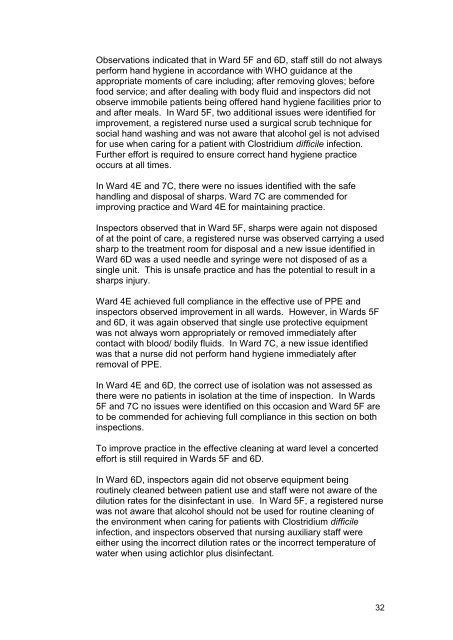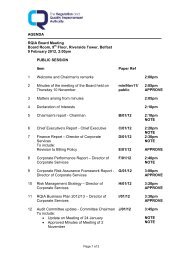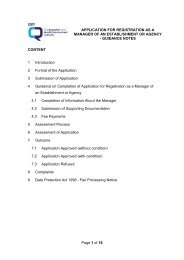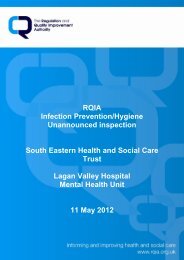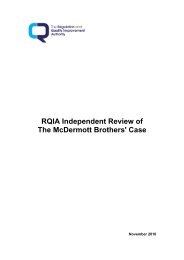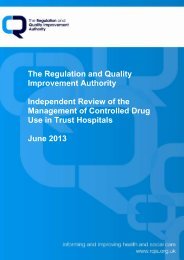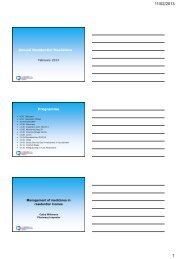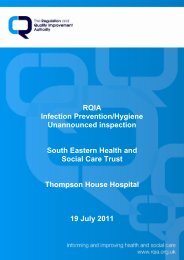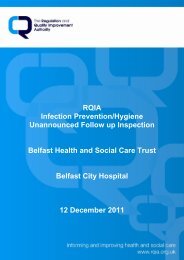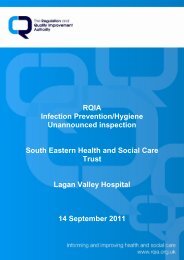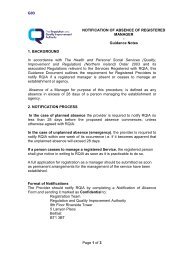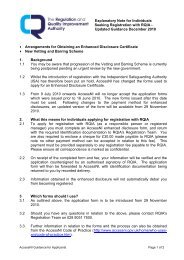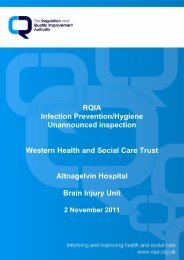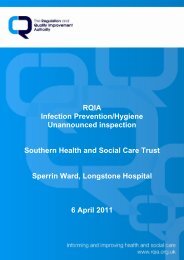(Re-audit) - 14 July 2011 - Regulation and Quality Improvement ...
(Re-audit) - 14 July 2011 - Regulation and Quality Improvement ...
(Re-audit) - 14 July 2011 - Regulation and Quality Improvement ...
You also want an ePaper? Increase the reach of your titles
YUMPU automatically turns print PDFs into web optimized ePapers that Google loves.
Observations indicated that in Ward 5F <strong>and</strong> 6D, staff still do not always<br />
perform h<strong>and</strong> hygiene in accordance with WHO guidance at the<br />
appropriate moments of care including; after removing gloves; before<br />
food service; <strong>and</strong> after dealing with body fluid <strong>and</strong> inspectors did not<br />
observe immobile patients being offered h<strong>and</strong> hygiene facilities prior to<br />
<strong>and</strong> after meals. In Ward 5F, two additional issues were identified for<br />
improvement, a registered nurse used a surgical scrub technique for<br />
social h<strong>and</strong> washing <strong>and</strong> was not aware that alcohol gel is not advised<br />
for use when caring for a patient with Clostridium difficile infection.<br />
Further effort is required to ensure correct h<strong>and</strong> hygiene practice<br />
occurs at all times.<br />
In Ward 4E <strong>and</strong> 7C, there were no issues identified with the safe<br />
h<strong>and</strong>ling <strong>and</strong> disposal of sharps. Ward 7C are commended for<br />
improving practice <strong>and</strong> Ward 4E for maintaining practice.<br />
Inspectors observed that in Ward 5F, sharps were again not disposed<br />
of at the point of care, a registered nurse was observed carrying a used<br />
sharp to the treatment room for disposal <strong>and</strong> a new issue identified in<br />
Ward 6D was a used needle <strong>and</strong> syringe were not disposed of as a<br />
single unit. This is unsafe practice <strong>and</strong> has the potential to result in a<br />
sharps injury.<br />
Ward 4E achieved full compliance in the effective use of PPE <strong>and</strong><br />
inspectors observed improvement in all wards. However, in Wards 5F<br />
<strong>and</strong> 6D, it was again observed that single use protective equipment<br />
was not always worn appropriately or removed immediately after<br />
contact with blood/ bodily fluids. In Ward 7C, a new issue identified<br />
was that a nurse did not perform h<strong>and</strong> hygiene immediately after<br />
removal of PPE.<br />
In Ward 4E <strong>and</strong> 6D, the correct use of isolation was not assessed as<br />
there were no patients in isolation at the time of inspection. In Wards<br />
5F <strong>and</strong> 7C no issues were identified on this occasion <strong>and</strong> Ward 5F are<br />
to be commended for achieving full compliance in this section on both<br />
inspections.<br />
To improve practice in the effective cleaning at ward level a concerted<br />
effort is still required in Wards 5F <strong>and</strong> 6D.<br />
In Ward 6D, inspectors again did not observe equipment being<br />
routinely cleaned between patient use <strong>and</strong> staff were not aware of the<br />
dilution rates for the disinfectant in use. In Ward 5F, a registered nurse<br />
was not aware that alcohol should not be used for routine cleaning of<br />
the environment when caring for patients with Clostridium difficile<br />
infection, <strong>and</strong> inspectors observed that nursing auxiliary staff were<br />
either using the incorrect dilution rates or the incorrect temperature of<br />
water when using actichlor plus disinfectant.<br />
32


